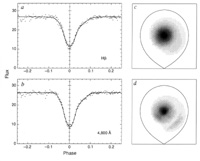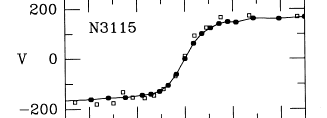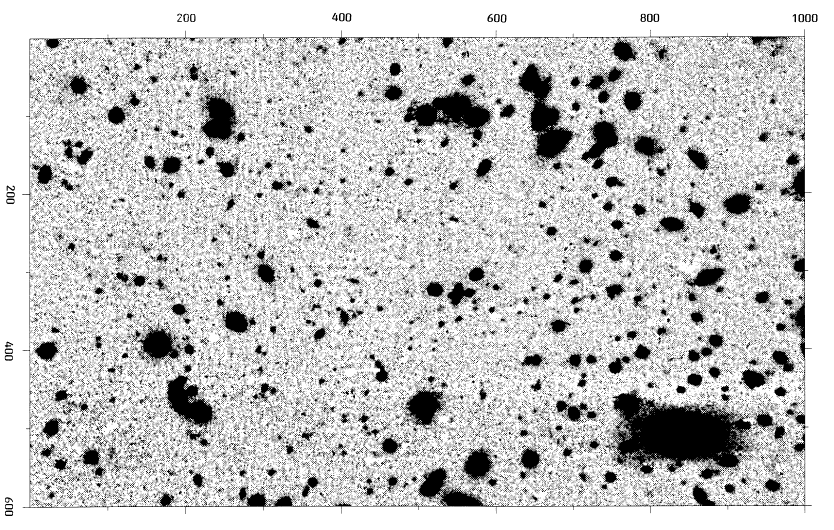 | |||
|
| Home > Public Information > Scientific Highlights > 1994 |
|
in 1994* *Astronomical discoveries following from observations carried out with the ING telescopes |
[ SOLAR SYSTEM | STARS | GALAXIES | OBSERVATIONAL COSMOLOGY | OTHER ]
|
|
||
|
||
| More information
ING facilities involved:
|
ASTEROIDS
 Different
taxonomic groups in the asteroid belt are prevalent in certain ranges of
heliocentric distance a. The majority of distant asteroids have
surfaces of low albedo material whose colour varies from the grey C-type
asteroids found at around a=3 au to the redder P- and D-types found
progressively further out. Since cometary nuclei also exhibit low albedos,
and cometary dust is neutral to red in colour, it has been suggested that
there could be a link between asteroids and comets. A cometary nucleus
that ceased to outgas could perhaps end up as an inert body like an ordinary
asteroid.
Different
taxonomic groups in the asteroid belt are prevalent in certain ranges of
heliocentric distance a. The majority of distant asteroids have
surfaces of low albedo material whose colour varies from the grey C-type
asteroids found at around a=3 au to the redder P- and D-types found
progressively further out. Since cometary nuclei also exhibit low albedos,
and cometary dust is neutral to red in colour, it has been suggested that
there could be a link between asteroids and comets. A cometary nucleus
that ceased to outgas could perhaps end up as an inert body like an ordinary
asteroid.
With this in mind, researchers
set out to investigate the reflectance properties of 19 D-type asteroids
using the WHT Faint Object Spectrograph. Two asteroids, 102 Miriam and
914 Palisana, exhibited strong UV absorption, characterisitc of phyllosilicates,
indicating that they are in fact more correctly classified as C-types.
The colours of the remainder were quantified by the slopes of their reflectance
spectra. A previously reported heliocentric colour gradient within the
D-types was not confirmed, but is not ruled out by the new data. A reflectance-slope
diameter correlation for D-types is confirmed in the sense that the smaller
asteroids tend to be redder. It is possible that the redder objects are
made of intrinsically weaker material and are less resistant to break-up
by impacts. Although the D-type asteroids observed have very similar albedos
(0.037 ± 0.007) to cometary nuclei, they possess a less diverse
range of reflectance properties than cometary nuclei and are better defined
as a group by their surfaces. Cometary nuclei cannot therefore be regarded
as the spectral analogues of D-type asteroids in general, though the D-types
are spectrally similar to some comets. If there is an evolutionary link,
this could be explained if the surface compositions have altered over their
lifetimes.
| More information
ING facilities involved:
|
SUPERNOVAE
 Remarkably,
after SN1993J, the period from March '94 to August '94 was to see the discovery
of three further exceptional supernovae. The explosion of SN1994D in March
1994 was the closest thermonuclear (ie type Ia) event for 22 years. In
April, SN1994I was discovered in M51, the brightest type Ib/c event for
eight years, and in July, SN1994W appeared, one of the most peculiar type
II supernovae ever seen. Following the success of the SN1993J archive,
the observing programme and archive was extended to include the other three
supernovae as well.
Remarkably,
after SN1993J, the period from March '94 to August '94 was to see the discovery
of three further exceptional supernovae. The explosion of SN1994D in March
1994 was the closest thermonuclear (ie type Ia) event for 22 years. In
April, SN1994I was discovered in M51, the brightest type Ib/c event for
eight years, and in July, SN1994W appeared, one of the most peculiar type
II supernovae ever seen. Following the success of the SN1993J archive,
the observing programme and archive was extended to include the other three
supernovae as well.
The La Palma observations provided excellent pre- and post-maximal optical coverage of SN1994D, demonstrating that it was a classic type Ia supernova, believed to be caused by thermonuclear fusion of carbon and oxygen in a white dwarf in a binary system. The data included the first ever pre-maximum light coverage of a normal type Ia in the 8500 to 10000Å range. The earliest spectra provided a goldmine of information about the outer layers of the explosion, and possibly about the progenitor system as well.
A type Ic supernova such as 1994I is a core-collapse event characterised by absent or weak hydrogen lines without the strong helium lines of a type Ib. It may have been a progenitor in a close binary system which has lost both its hydrogen and helium rich envelopes before collapse. To improve understanding of these events, good spectral coverage is required, and it is hoped to continue monitoring into 1995.
Features in the spectra of the
very peculiar type II supernova SN1994W appear to have come from two regions:
broad hydrogen and helium emission from the rapidly moving ejecta, and
narrow P Cygni features from a slow moving dense circumstellar wind, ionised
by the EUV flash and now scattering part of the subsequently emitted optical
light.
| More information
ING facilities involved:
|
SPECTRALLY RESOLVED ECLIPSE MAPS OF AN
ACCRETION DISK
 Accretion
disks play an important role in many astrophysical environments, such as
active galactic nuclei, protostellar systems, X-ray binaries and cataclysmic
variables. The lack of spatially resolved information, however, has meant
that theoretical models for accretion disks are in general poorly constrained
by observations. By using the shape of the light curves from an an eclipsing
cataclysmic variable, UX Ursae Majoris, astronomers have reconstructed
the spectral energy distribution across the face of an accretion disk.
The spectral resolution is sufficient to reveal both the radial dependence
of absorption and emission line features within the disk, and the spectral
details of the bright spot formed at the point where the accretion stream
from the secondary star collides with the disk. Such detailed reconstructions
of accretion-disk spectra will help to bridge the gap between observations
and theoretical models.
Accretion
disks play an important role in many astrophysical environments, such as
active galactic nuclei, protostellar systems, X-ray binaries and cataclysmic
variables. The lack of spatially resolved information, however, has meant
that theoretical models for accretion disks are in general poorly constrained
by observations. By using the shape of the light curves from an an eclipsing
cataclysmic variable, UX Ursae Majoris, astronomers have reconstructed
the spectral energy distribution across the face of an accretion disk.
The spectral resolution is sufficient to reveal both the radial dependence
of absorption and emission line features within the disk, and the spectral
details of the bright spot formed at the point where the accretion stream
from the secondary star collides with the disk. Such detailed reconstructions
of accretion-disk spectra will help to bridge the gap between observations
and theoretical models.
| More information
ING facilities involved:
|
ELLIPTICAL GALAXIES
 An
extensive campaign to obtain surface photometry of a complete magnitude-limited
sample of 56 elliptical galaxies from the Revised Shapley-Ames catalogue
was completed by researchers. CCD photometry in B, V, and I was obtained
from the JKT (for the northern sample) and various telescopes at ESO (for
the south). Radial profiles of surface brightness, B-V, V-I and ellipticity
were determined, together with third and fourth-order Fourier coefficients
that quantify the deviations of these profiles from perfect ellipses. These
coefficients prove to be sensitive diagnostics of the presence of dust.
Narrow-band interference-filter photometry was also obtained in H alpha
+ [N II] to map the amount and morphology of dust and ionised gas. Optical
long-slit spectroscopy was performed on the WHT, the INT and at ESO to
determine the ratio of [N II] to H alpha. Dust lanes or patches were detected
in 23 of the galaxies: allowing for selection effects the true fraction
of elliptical galaxies containing dust is estimated to be about 80%. Ionised
gas was detected in 32 galaxies, with emission line intensity ratios typical
of LINER nuclei. The amounts of dust and gas detected are small: about
104 or 105
solar masses of ionised gas. The dust and ionised gas show a wide variety
of distributions which are consistent with the gas and dust being physically
associated, including some cases of patchy or filamentary structure suggestive
of a recent interaction event.
An
extensive campaign to obtain surface photometry of a complete magnitude-limited
sample of 56 elliptical galaxies from the Revised Shapley-Ames catalogue
was completed by researchers. CCD photometry in B, V, and I was obtained
from the JKT (for the northern sample) and various telescopes at ESO (for
the south). Radial profiles of surface brightness, B-V, V-I and ellipticity
were determined, together with third and fourth-order Fourier coefficients
that quantify the deviations of these profiles from perfect ellipses. These
coefficients prove to be sensitive diagnostics of the presence of dust.
Narrow-band interference-filter photometry was also obtained in H alpha
+ [N II] to map the amount and morphology of dust and ionised gas. Optical
long-slit spectroscopy was performed on the WHT, the INT and at ESO to
determine the ratio of [N II] to H alpha. Dust lanes or patches were detected
in 23 of the galaxies: allowing for selection effects the true fraction
of elliptical galaxies containing dust is estimated to be about 80%. Ionised
gas was detected in 32 galaxies, with emission line intensity ratios typical
of LINER nuclei. The amounts of dust and gas detected are small: about
104 or 105
solar masses of ionised gas. The dust and ionised gas show a wide variety
of distributions which are consistent with the gas and dust being physically
associated, including some cases of patchy or filamentary structure suggestive
of a recent interaction event.
| More
information
ING facilities involved:
|
GALACTIC MODELS
 The
presence of a massive black-hole has been invoked to explain the observed
rotation velocities and velocity dispersions at the centres of a number
of galaxies of various classes, including M31, M32, NGC 3115 and NGC 4594.
The
presence of a massive black-hole has been invoked to explain the observed
rotation velocities and velocity dispersions at the centres of a number
of galaxies of various classes, including M31, M32, NGC 3115 and NGC 4594.
Researchers measured stellar line-of-sight velocity profiles of these galaxies from high resolution, high signal-to-noise, long-slit spectroscopy using both ISIS on the WHT and the Multiple Mirror Telescope on Mount Hopkins. In all objects, significant deviations of the velocity profiles from Gaussian were found which are not accounted for by projection or seeing effects. The strongest deviations are asymmetries, primarily along the major axis, which indicate an excess of stars at low rotation velocities.
These velocity profiles rule out
certain existing dynamical models. A new model for M32 has been constructed
taking proper account of the new data, consistent with the central luminosity
'spike' being completely non-thermal. The observed velocity distributions
near the centre can be fitted equally well by radially anisotropic models
with a central black hole of mass no more than about 5 x 109
solar masses.
| More information
ING facilities involved:
|
HIGH Z RADIO GALAXIES
 In
principle, radio galaxies are sufficiently luminous that they can be observed
out to a redshift of z=5, and the properties of objects at such high redshifts
are of great astrophysical interest. Unfortunately the geometry of the
Universe, the luminosity function and a probably drop in the numbers of
radio sources past z=2 all conspire to make z=3 objects very rare.
In
principle, radio galaxies are sufficiently luminous that they can be observed
out to a redshift of z=5, and the properties of objects at such high redshifts
are of great astrophysical interest. Unfortunately the geometry of the
Universe, the luminosity function and a probably drop in the numbers of
radio sources past z=2 all conspire to make z=3 objects very rare.
A search for high redshift radio
galaxies was conducted by a consortium of researchers, who selected objects
at a frequency of 38 MHz with unusual radio spectra: some had steep, straight
spectra and some had highly curved spectra that flattened or turned over
at low frequency. VLA maps of the selected candidates provided positions
that were sufficiently accurate for optical spectroscopy without further
imaging, and follow-up spectra were obtained with ISIS on the WHT. One
candidate, 8C1435+635, showed a resolved, spatially extended emission line
centered on 639.0 nm with several components with velocities between -1500
and +700 kms-1. A further line object was
detected at 820.5nm. Identifying these with lyman alpha and C IV yields
a (Ly alpha) redshift of z=4.255, the most distant galaxy known. The radio
luminosity, even allowing for possible gravitational amplification, places
it at the very top of the radio luminosity function, suggesting that the
evolution of radio-loud AGN at high redshift may be similar to the radio-quiet
quasars.
| More information
ING facilities involved:
|
DWARF GALAXY POPULATIONS
 The
surface density of faint galaxies significantly exceeds what would be expected
if the observed properties of local field galaxies were simply extrapolated
to large redshift under the assumption of no evolution. The deepest optical
counts are inconsistent with no evolution or even modest evolution irrespective
of cosmological model, and show that galaxy colours are bluer at higher
apparent magnitudes. Most models devised to account for the excess galaxies
seen in the number-magnitude counts invoke a large population of low-luminosity
galaxies at moderate redshifts.
The
surface density of faint galaxies significantly exceeds what would be expected
if the observed properties of local field galaxies were simply extrapolated
to large redshift under the assumption of no evolution. The deepest optical
counts are inconsistent with no evolution or even modest evolution irrespective
of cosmological model, and show that galaxy colours are bluer at higher
apparent magnitudes. Most models devised to account for the excess galaxies
seen in the number-magnitude counts invoke a large population of low-luminosity
galaxies at moderate redshifts.
Astronomers investigated the faint
end of the luminosity function directly at moderate z (=0.2) using deep
R-band observations of the Abell distant cluster A963 made with the Hitch-hiker
parallel CCD camera on the WHT. By subtracting a mean-field component from
the observed galaxy counts in the cluster area, they deduced the existence
of a large drawf population in the cluster, giving rise to a significant
excess over the mean down to the sample limit at mR=24.5.
The implied dwarf galaxy luminosity function has a steep slope, alpha=-1.8.
| More information
ING facilities involved:
|
OTHER HIGHLIGHTS
The Crab nebula, the remnant of the supernova of 1054 and thought to have been a type II supernova, has been shown to have a diffuse halo out to about 2 arcminutes beyond the edge of the nebula. The mass of this halo has proven to be about 4 solar masses, and when added to the 4 solar masses already visible gives a progenitor mass of 8 solar masses. Theories about Type II supernovae say that the progenitors must have at least a mass of 8 solar masses to explode, and the Crab is now in agreement with this. (Murdin, 1994, MNRAS, 269, 89).
The first determination of a distance to a High Velocity Cloud (HVC) has been made using WHT and JKT spectroscopy. These techniques have been used by other researchers to study a number of halo and disk HVC's using the INT. (Little et al, 1994, ApJ, 427, 267; Shaw et al, 1994, Spectrum, No.3, 8; Centurión et al, 1994, Aston Astrophys, 292, 261.
New white dwarfs have been found
using the INT and JKT doing optical follow-ups on ROSAT and EUV surveys.
One of these objects was the hottest hydrogen-rich DA white dwarf detected.
(Barstow et al, 1994, MNRAS, 271, 175). Also found in the
same follow-ups was a new AM Her system, which has the shortest period
known for this type of object. (Osborne et al, 1994, MNRAS, 270,
650).


